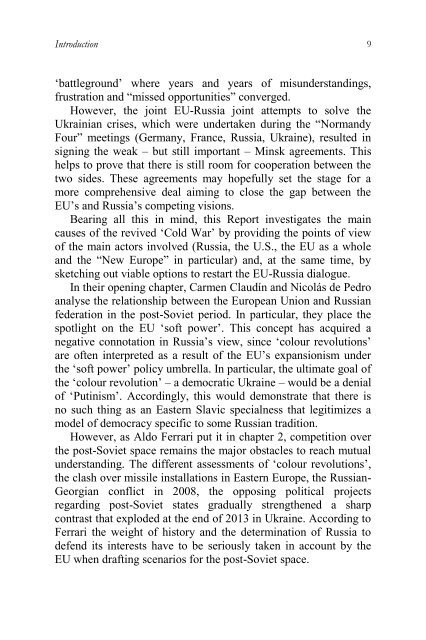beyondukraine.euandrussiainsearchofanewrelation
beyondukraine.euandrussiainsearchofanewrelation
beyondukraine.euandrussiainsearchofanewrelation
Create successful ePaper yourself
Turn your PDF publications into a flip-book with our unique Google optimized e-Paper software.
Introduction 9<br />
‘battleground’ where years and years of misunderstandings,<br />
frustration and “missed opportunities” converged.<br />
However, the joint EU-Russia joint attempts to solve the<br />
Ukrainian crises, which were undertaken during the “Normandy<br />
Four” meetings (Germany, France, Russia, Ukraine), resulted in<br />
signing the weak – but still important – Minsk agreements. This<br />
helps to prove that there is still room for cooperation between the<br />
two sides. These agreements may hopefully set the stage for a<br />
more comprehensive deal aiming to close the gap between the<br />
EU’s and Russia’s competing visions.<br />
Bearing all this in mind, this Report investigates the main<br />
causes of the revived ‘Cold War’ by providing the points of view<br />
of the main actors involved (Russia, the U.S., the EU as a whole<br />
and the “New Europe” in particular) and, at the same time, by<br />
sketching out viable options to restart the EU-Russia dialogue.<br />
In their opening chapter, Carmen Claudín and Nicolás de Pedro<br />
analyse the relationship between the European Union and Russian<br />
federation in the post-Soviet period. In particular, they place the<br />
spotlight on the EU ‘soft power’. This concept has acquired a<br />
negative connotation in Russia’s view, since ‘colour revolutions’<br />
are often interpreted as a result of the EU’s expansionism under<br />
the ‘soft power’ policy umbrella. In particular, the ultimate goal of<br />
the ‘colour revolution’ – a democratic Ukraine – would be a denial<br />
of ‘Putinism’. Accordingly, this would demonstrate that there is<br />
no such thing as an Eastern Slavic specialness that legitimizes a<br />
model of democracy specific to some Russian tradition.<br />
However, as Aldo Ferrari put it in chapter 2, competition over<br />
the post-Soviet space remains the major obstacles to reach mutual<br />
understanding. The different assessments of ‘colour revolutions’,<br />
the clash over missile installations in Eastern Europe, the Russian-<br />
Georgian conflict in 2008, the opposing political projects<br />
regarding post-Soviet states gradually strengthened a sharp<br />
contrast that exploded at the end of 2013 in Ukraine. According to<br />
Ferrari the weight of history and the determination of Russia to<br />
defend its interests have to be seriously taken in account by the<br />
EU when drafting scenarios for the post-Soviet space.


